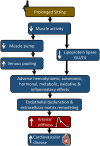The 24-h activity cycle and cardiovascular outcomes: establishing biological plausibility using arterial stiffness as an intermediate outcome
- PMID: 37737729
- PMCID: PMC11932535
- DOI: 10.1152/ajpheart.00258.2023
The 24-h activity cycle and cardiovascular outcomes: establishing biological plausibility using arterial stiffness as an intermediate outcome
Abstract
This review proposes a biologically plausible working model for the relationship between the 24-h activity cycle (24-HAC) and cardiovascular disease. The 24-HAC encompasses moderate-to-vigorous physical activity (MVPA), light physical activity, sedentary behavior (SB), and sleep. MVPA confers the greatest relative cardioprotective effect, when considering MVPA represents just 2% of the day if physical activity guidelines (30 min/day) are met. While we have well-established guidelines for MVPA, those for the remaining activity behaviors are vague. The vague guidelines are attributable to our limited mechanistic understanding of the independent and additive effects of these behaviors on the cardiovascular system. Our proposed biological model places arterial stiffness, a measure of vascular aging, as the key intermediate outcome. Starting with prolonged exposure to SB or static standing, we propose that the reported transient increases in arterial stiffness are driven by a cascade of negative hemodynamic effects following venous pooling. The subsequent autonomic, metabolic, and hormonal changes further impair vascular function. Vascular dysfunction can be offset by using mechanistic-informed interruption strategies and by engaging in protective behaviors throughout the day. Physical activity, especially MVPA, can confer protection by chronically improving endothelial function and associated protective mechanisms. Conversely, poor sleep, especially in duration and quality, negatively affects hormonal, metabolic, autonomic, and hemodynamic variables that can confound the physiological responses to next-day activity behaviors. Our hope is that the proposed biologically plausible working model will assist in furthering our understanding of the effects of these complex, interrelated activity behaviors on the cardiovascular system.
Keywords: activity behaviors; biological plausibility; physical activity; pulse wave velocity; sedentary behavior; sleep.
Conflict of interest statement
The authors declare no conflicts of interest.
Figures




Similar articles
-
Association of Objectively Measured Sedentary Behavior With Arterial Stiffness: Findings From the Nijmegen Exercise Study.Scand J Med Sci Sports. 2024 Nov;34(11):e14757. doi: 10.1111/sms.14757. Scand J Med Sci Sports. 2024. PMID: 39501785
-
Association of time spent in physical activities and sedentary behaviors with carotid-femoral pulse wave velocity: A systematic review and meta-analysis.Atherosclerosis. 2018 Feb;269:211-218. doi: 10.1016/j.atherosclerosis.2018.01.009. Epub 2018 Jan 17. Atherosclerosis. 2018. PMID: 29407596
-
Investigating the influence of physical activity composition on arterial stiffness in youth.Eur J Sport Sci. 2023 Apr;23(4):617-624. doi: 10.1080/17461391.2022.2039304. Epub 2022 Mar 1. Eur J Sport Sci. 2023. PMID: 35135413
-
Arterial stiffness and the reallocation of time between device-measured 24-hour movement behaviours: A compositional data analysis.Atherosclerosis. 2023 Aug;379:117185. doi: 10.1016/j.atherosclerosis.2023.117185. Epub 2023 Jul 5. Atherosclerosis. 2023. PMID: 37531669
-
The impact of the 24-h movement spectrum on vascular remodeling in older men and women: a review.Am J Physiol Heart Circ Physiol. 2021 Mar 1;320(3):H1136-H1155. doi: 10.1152/ajpheart.00754.2020. Epub 2021 Jan 15. Am J Physiol Heart Circ Physiol. 2021. PMID: 33449851 Review.
Cited by
-
The effect of cardiorespiratory fitness and habitual physical activity on cardiovascular responses to 2 h of uninterrupted sitting.J Appl Physiol (1985). 2024 May 1;136(5):1087-1096. doi: 10.1152/japplphysiol.00361.2023. Epub 2024 Mar 14. J Appl Physiol (1985). 2024. PMID: 38482575 Free PMC article.
-
Associations of nonoccupational sedentary behaviors with cardiometabolic outcomes: coronary artery risk development in young adults (CARDIA).Ann Behav Med. 2025 Jan 4;59(1):kaae074. doi: 10.1093/abm/kaae074. Ann Behav Med. 2025. PMID: 39671511 Free PMC article.
-
Adherence to 24-hour movement guidelines in adolescence and its association with lower risk of hypertension in adulthood.World J Pediatr. 2025 Mar;21(3):284-290. doi: 10.1007/s12519-025-00880-z. Epub 2025 Mar 6. World J Pediatr. 2025. PMID: 40048125 Free PMC article.
-
Acute Psychological Stress and Pulse Wave Velocity: Meta-Analysis and Recommendations for Future Research.Psychophysiology. 2025 May;62(5):e70068. doi: 10.1111/psyp.70068. Psychophysiology. 2025. PMID: 40346916 Free PMC article. Review.
References
-
- Matthews CE, George SM, Moore SC, Bowles HR, Blair A, Park Y, Troiano RP, Hollenbeck A, Schatzkin A. Amount of time spent in sedentary behaviors and cause-specific mortality in US adults. Am J Clin Nutr 95: 437–445, 2012. doi:10.3945/ajcn.111.019620.Am. - DOI - PMC - PubMed
-
- Katzmarzyk PT, Powell KE, Jakicic JM, Troiano RP, Piercy K, Tennant B; 2018 Physical Activity Guidelines Advisory Committee. Sedentary behavior and health: update from the 2018 Physical Activity Guidelines Advisory Committee. Med Sci Sports Exerc 51: 1227–1241, 2019. doi:10.1249/MSS.0000000000001935. - DOI - PMC - PubMed
-
- Wolff TA, Krist AH, LeFevre M, Jonas DE, Harris RP, Siu A, Owens DK, Gillman MW, Ebell MH, Herzstein J, Chou R, Whitlock E, Bibbins-Domingo K. Update on the methods of the U.S. Preventive Services Task Force: linking intermediate outcomes and health outcomes in prevention. Am J Prev Med 54: S4–S10, 2018. doi:10.1016/j.amepre.2017.08.032. - DOI - PubMed
Publication types
MeSH terms
Grants and funding
LinkOut - more resources
Full Text Sources
Miscellaneous

